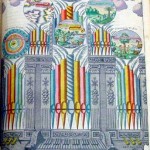In his magnum opus on light, projections, and astronomy, Ars Magna Lucis Et Umbrae (“the Great Art of Light and Shadows,” polymath Jesuit scholar and inventor Athanasius Kircher (1601-1680) describes several spaces of his invention lying between an optical device and an architectural
(dark room) whose size of an actual, inhabitable room, could enable one artist to stay inside. The room is described as a portable device, a sort of sedan-chair, which could be placed in every setting.
A cubic exterior shell would be equipped with lenses located at the
The camera obscura enhances a natural optical phenomenon which consists in the projection of a scene through a small hole as a reversed and mirrored image on a surface on the opposite side. In order for the phenomenon to be observed clearly, the area close to the projected image must be darkened. A device like the one described by Kircher would enhance the natural phenomenon through the addition of a lens in correspondence to the hole. Artists would use the camera obscura to get exact, although reversed, projections of a subject they intended to represent. Such a device, based on optical studies and mimicking the functioning of the human eye, would later become the basis for the conception of the photo camera.
Enlarged to reach the side of a room, Kircher’s camera obscura enables the physical and symbolic inhabitation of the process of vision and that of imagination through perception, because images are formed in the mind after vision has first taken place. In La Dioptrique (1637), Descartes refers to the camera obscura to explain the functioning of vision and the passage of images from the material dimension to the mental one, symbolized in the famous drawing of a bearded man observing the projection on the retina.

Athanasius Kircher, Camera obscura, 1646.

Athanasius Kircher, Ars Magna Lucis Et Umbrae, 1646, (book cover).

Rene Descartes, La Dioptrique, 1637, (cover).



Leave a Reply